I’ll never forget my first night under nylon fabric – the crunch of twigs beneath my sleeping pad, the midnight symphony of crickets, and that persistent rock I’d somehow missed during setup. Camping transforms landscapes into bedrooms, but mastering outdoor rest? That took years of lumpy trial runs and gear experiments.
What changed everything? Learning to treat my tent like a backcountry sanctuary. The right campsite (flat, sheltered, rock-free) became my non-negotiable foundation. A three-season sleeping bag replaced my college-era relic. I even developed a twilight ritual – hot tea, earplugs, star-gazing – that signals to my body: time to recharge.
Through countless trips from Smoky Mountain trails to desert campgrounds, I’ve discovered sleeping outdoors isn’t about toughness. It’s about harmony – balancing preparation with adaptability. This guide blends hard-won wisdom from trail veterans with the kind of practical tweaks that turn restless nights into deep, pine-scented slumber.
Table of Contents
Key Takeaways
- Ground preparation is crucial for comfort – always scout your tent site thoroughly
- Invest in quality insulation that matches your camping climate
- Personal sleep routines adapt surprisingly well to outdoor environments
- Wind direction and terrain slope impact rest more than most realize
- Test your sleep system in backyard trials before major trips
Essential Preparations for a Cozy Tent Sleep
Imagine lying awake as a stray pinecone digs into your back – that’s how I learned campsite selection isn’t optional. Your daylight decisions shape nighttime comfort, turning uneven earth into a sanctuary. Scout during golden hour when shadows reveal hidden slopes and rock clusters.
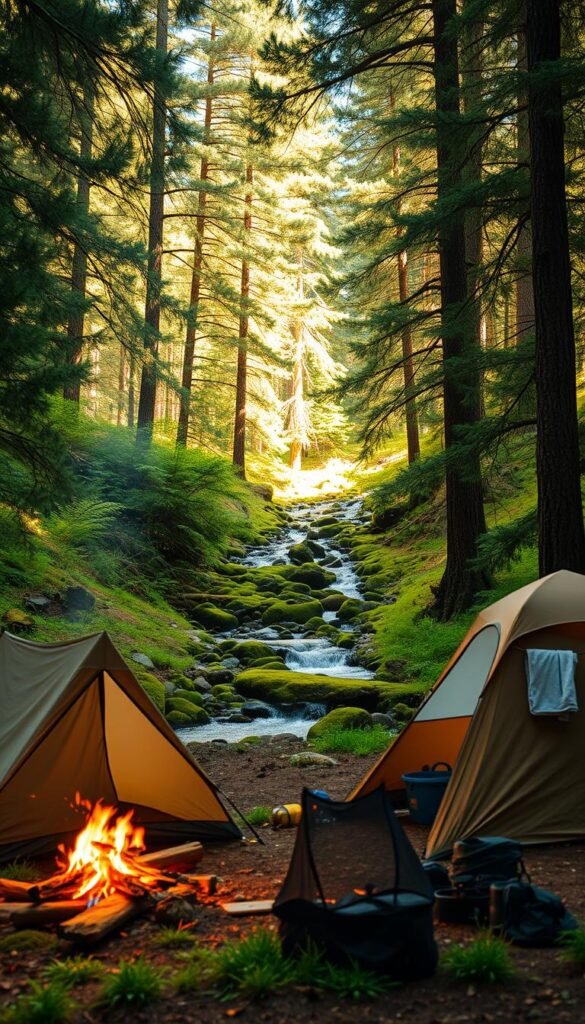
Selecting the Ideal Campsite
I’ve perfected the water bottle trick: place an unopened bottle on the ground. If it rolls, you’ll spend the day chasing gear downhill. Seek sites 200+ feet from trails – distant enough to muffle neighbor noise, close enough for midnight bathroom dashes.
Creating a Comfortable Sleep Area
Unroll your sleeping pad perpendicular to tent seams. This simple move eliminates cold spots better than any camping trip hack. Keep headlamps and water bottles in designated pockets – fumbling at bedtime disrupts that hard-won drowsiness.
Arrange your nest like home: pillow fluffed, bag unzipped for ventilation, boots pointing toward the door. Daylight prep pays off when moonlight reveals your perfectly organized sleep zone – a silent cue for your nervous system to power down.
Choosing and Setting Up the Perfect Tent for Rest
Rain pelted my rainfly as I wrestled with a rebellious tent stake in Colorado’s San Juan Mountains – a comedy of errors that taught me setup precision matters more than gear price tags. Your shelter becomes a climate-controlled cocoon only when ground alignment and airflow work in concert.
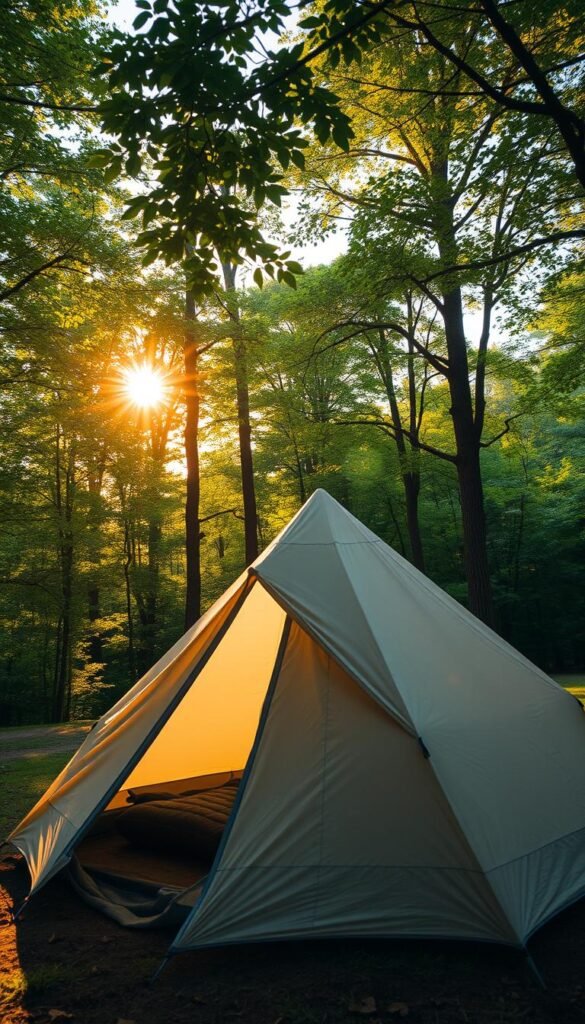
Pitching Techniques and Level Ground Tips
Use trekking poles as makeshift rulers – measure diagonally across your tent footprint to confirm square corners. That “flat” patch of grass? Test it with your sleeping pad. If your hips sag left, rotate the tent 90 degrees. Pro tip: Stash extra tent stakes uphill – gravity loves stealing lightweight gear.
Waterproofing, Ventilation, and Protection from the Elements
I’ve woken to indoor rainstorms from poor condensation management. Now I crack vents opposite the wind direction, creating a cross-breeze that battles moisture without inviting drafts. Always check weather patterns before staking – that innocent-looking gully becomes a river during midnight downpours.
Seam-seal your tent in daylight, using a credit card to smooth gooey applications. For desert trips, angle the rainfly to create shaded air pockets. Tundra camping? Bury snow anchors like you’re planting storm-proof trees. The extra 15 minutes spent adjusting guylines and testing zippers pays off when winds howl and temperatures plummet.
Optimizing Your Sleep Gear: Bags, Pads, and Pillows
My coldest night outdoors wasn’t in the Rockies – it happened in a Florida swamp when my summer bag met unexpected 40°F temps. Gear choices make or break your outdoor rest, transforming shivers into serenity. Three elements form your mobile bedroom: the sleeping bag that cocoons, the pad that cushions, and the pillow that cradles.
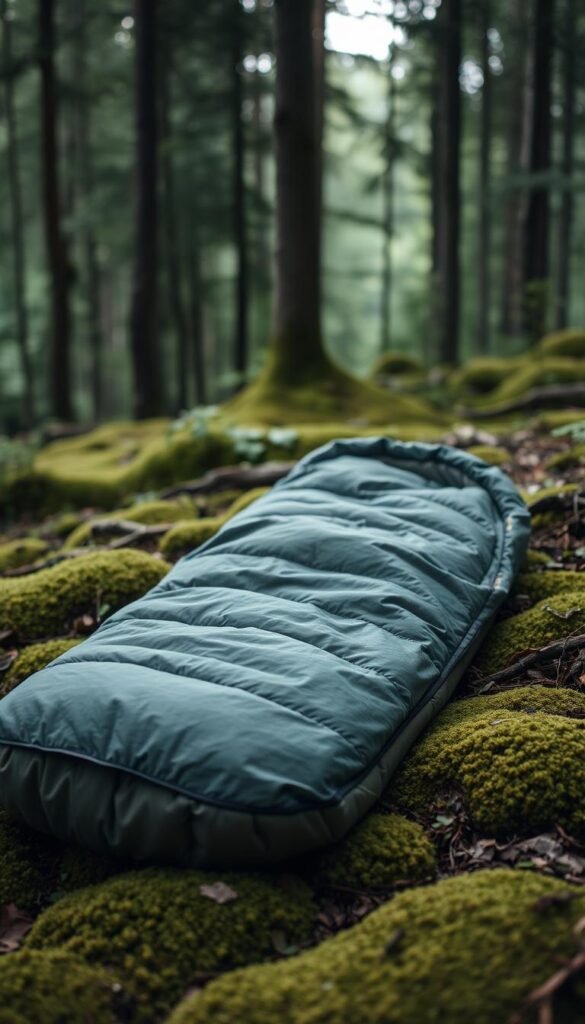
Decoding Temperature Ratings and Fit
Sleeping bags lie – or rather, their ratings do. That “20°F comfort rating” assumes you’re wearing base layers on a closed-cell foam pad. I always subtract 10°F from forecast lows when choosing bags. Mummy styles trap heat best, while rectangular bags suit restless sleepers. Zip it halfway if you overheat – ventilation prevents midnight strip-downs.
Padding Your Palace
Your sleeping pad does double duty: cushioning hips from roots and insulating from ground chill. Compare these options:
| Type | R-Value | Weight | Best For |
|---|---|---|---|
| Foam | 2.0 | 1 lb | Summer/Backup |
| Self-Inflating | 3.5 | 2.5 lbs | 3-Season |
| Air | 4.8 | 1.2 lbs | Winter |
Camp pillows spark debates fiercer than tent vs hammock. Inflatable ones pack small but crinkle. Compressible models feel homier but bulk up. I stuff a fleece jacket into a stuff sack – free multi-use luxury.
Always pack repair tape and an emergency foam mat. That ultralight pad? It’ll spring a leak when temperatures dive. Test your system in the backyard first – better to discover cold spots where your coffee maker awaits.
How to Sleep Better in a Tent: Tips for Restful Nights
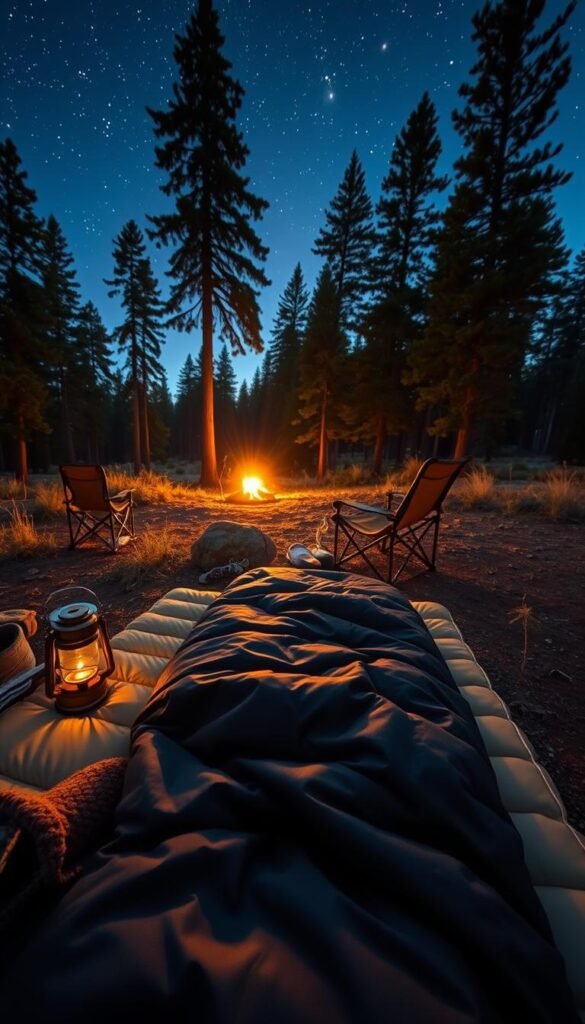
There’s magic in waking refreshed beneath swaying pines – that hard-earned skill comes through deliberate practice. After fifteen years of tweaking my sleep system, I’ve learned three non-negotiables: thermal regulation beats luxury, organization trumps space, and mindset matters as much as gear.
Your bed begins long before sunset. I arrange my sleeping bag like clockwork – unzipped during dinner to air out, then pre-warmed with body heat during evening tea. This ritual helps my internal clock recognize rest time, even without bedside lamps or city noise.
Temperature control makes or breaks your night. I once survived a Montana cold snap by layering a fleece liner inside my bag and wearing mittens to bed. Now I always check mountain weather patterns – preparation turns potential disasters into cozy adventures. Remember: ventilation prevents condensation, while strategic insulation stops ground chill.
Space management transforms cramped quarters. Store gear in labeled dry bags along tent walls, creating clear pathways. I position my pillow at a slight incline – mimicking my home setup – which eases the transition to wilderness rest. The right pillow height (tested during backyard trials) prevents neck strain better than any trailside fix.
Through countless starry nights, I’ve discovered outdoor sleep isn’t about perfection. It’s about creating familiar rhythms in wild spaces – the measured breath of zippers closing, the soft rustle of a well-organized sleeping area, the quiet confidence of tested gear. When these elements align, even unfamiliar terrain becomes a sanctuary for deep, rejuvenating slumber.
Coping with Environmental Challenges and Noise
Wind whispered through pine needles like restless spirits – my initiation into nature’s unpredictable lullabies. Wilderness rest demands adaptation, transforming distractions into background ambiance. The key lies in layering defenses against disruptions while preserving your connection to the environment.
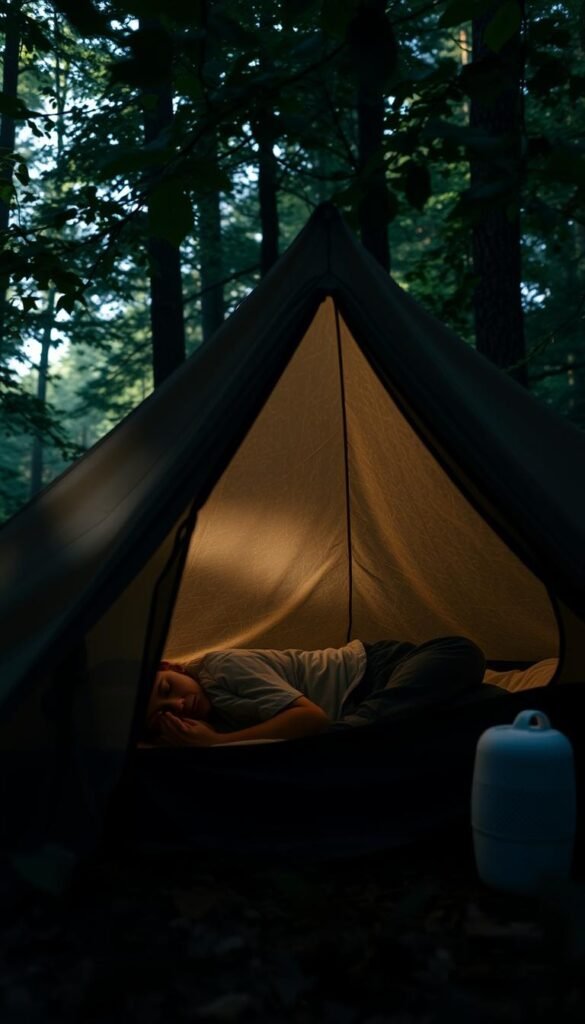
Silencing Nature’s Interruptions
I’ve slept through thunderstorms using earplugs dipped in wax – their malleable fit blocks crackling campfires and rustling critters. For light sleepers, a beanie pulled low over ears muffles sounds without total isolation. Pro tip: Angle your tent away from trails and water sources to minimize midnight raccoon parades.
White noise apps work wonders, but I prefer nature’s version. Positioning near a steady stream masks erratic noises like flapping tent fabric or distant voices. When middle night awakenings strike, focus on rhythmic patterns – owl hoots or wind in trees often sync with breath cycles.
Mastering the Light Dance
Moonlight transforms campsites into silver landscapes, but light pollution from neighboring tents? That’s fixable. Use red headlamps for bathroom trips – their warm glow preserves night vision without signaling UFO sightings. I secure a bandana over my eyes during bright phases, thin enough to sense dawn’s arrival.
Strategic tent placement helps too. Face vestibules away from rising sun paths, and stash electronics in opaque bags. For throughout night comfort, I layer a dimmable lantern under my rainfly – its soft diffusion mimics starlight without harsh beams.
Nighttime Routines and Sleep Enhancements
Moonlight paints the forest floor silver as I boil water for peppermint tea – this simple act bridges wilderness and comfort. Evening rituals become anchors in nature’s rhythm, helping urban-tuned minds embrace outdoor rest. Your routine needn’t be elaborate, just consistent enough to whisper: release the day’s adventures.

Establishing a Relaxing Pre-Bed Ritual
I journal by headlamp’s red glow, jotting trail highlights while muscles unwind. Gentle hip stretches mimic the tent’s sloped walls – a physical body cue that rest approaches. Some nights, I count constellations through mesh ceilings; others, I listen to wind compose lullabies in pine needles.
Managing Nutrition, Hydration, and Body Temperature
Hydration strategy shifts at dusk: small sips replace gulps to minimize midnight exits. A walnut-sized portion of almond butter 90 minutes before bed stabilizes temperature without digestive drama. I layer wool socks and unzip my bag’s footbox – precise heat control trumps sweltering or shivering through darkness.
Through twenty-seven trips, I’ve learned this truth: predictable evening patterns ease the body into unfamiliar terrain. Whether sipping cinnamon tea or arranging tomorrow’s socks, these acts build neural pathways linking twilight rituals with deep, earth-scented slumber.
Troubleshooting Common Camping Sleep Issues
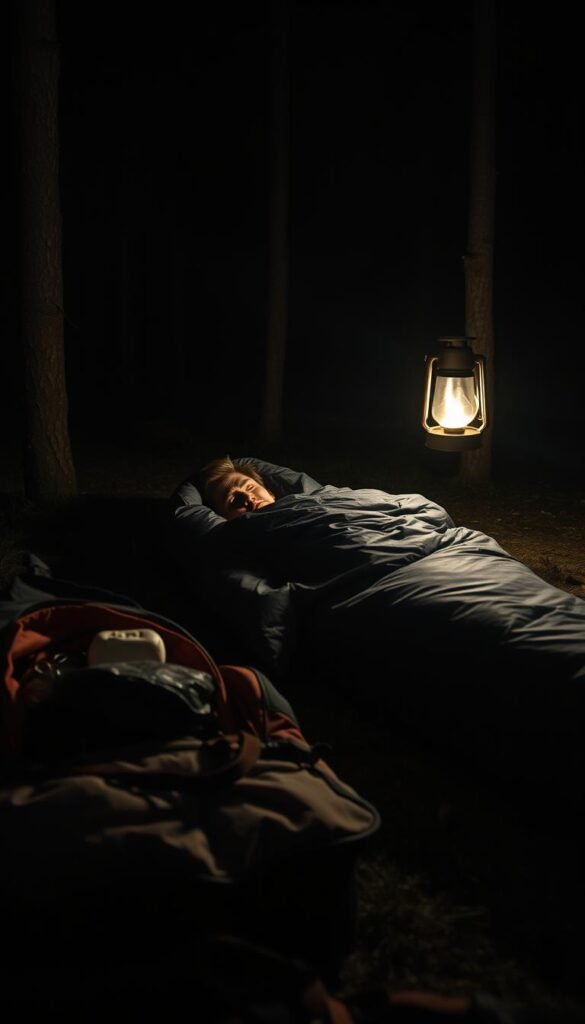
Midnight in Yosemite Valley taught me gear fails have perfect timing – my air pad hissed rebellion just as temperatures plunged. Through chattering teeth, I learned quick fixes beat perfect solutions when nature throws curveballs. Three principles guide my crisis management: adapt first, repair second, and always preserve core warmth.
Uneven ground plagues even seasoned campers. If your hips sag sideways, slide folded clothing under sleeping pads. Rotate your setup 180 degrees – sometimes a foot-level slope feels less intrusive. For persistent lumps, create a debris-free area using your pack as a temporary base.
When water invades your sanctuary, act fast. Elevate gear on waterproof stuff sacks and dig a trench around the tent perimeter. I’ve used trekking poles as makeshift clotheslines to dry soaked items overnight. For condensation battles, wipe walls with a microfiber cloth and crack vents – cross-ventilation works miracles.
- Patch air pads with duct tape (carry precut strips)
- Reposition guylines when wind changes direction
- Use spare socks as emergency pillowcases
Gear failures demand time management. Address leaks before sunset – cold fingers fumble repairs. Keep critical items accessible: headlamp, multitool, repair kits. I once jury-rigged a broken zipper with fishing line, turning a potential bailout into three more blissful nights under stars.
Weather shifts require layered responses. Add pine needles under your tent floor for insulation during unexpected chills. When rain threatens, angle sleeping pads slightly uphill – water follows gravity away from your nest. Remember: most crises become stories with quick thinking and a spare carabiner.
Conclusion
I once watched dawn blush across Utah’s canyonlands from my sleeping bag – fully rested despite coyote choruses and rocky terrain. That morning cemented a truth: great outdoor rest isn’t about conquering nature, but collaborating with it. Every wrinkled sleeping pad placement and moonlit gear adjustment becomes part of your wilderness rhythm.
The art lies in layered preparation. A well-chosen tent site becomes your foundation. Thoughtful gear selections – from temperature-rated bags to noise-dampening pillows – build comfort. Evening rituals whisper to your nervous system: this is safe space.
Expect stumbles. My first camping trip involved a deflating pad and a runaway water bottle. But each challenge taught me to adapt – stuffing clothes under hips, repositioning guylines mid-storm. Now I cherish these lessons as much as the serene nights.
Your perfect sleep system awaits in the overlap between preparation and experimentation. Try angled pillow placements. Test ground insulation tricks. Share discoveries around campfires. With each adjusted detail, you’ll find deeper connection to landscapes and rest that rejuvenates.
The stars still sing the same lullabies they did on my first trembling night under nylon. What changed? Not the wild – but how I choose to meet it. May your next night outdoors blend earned wisdom with childlike wonder, wrapped in the quiet confidence of tried-and-true comfort.

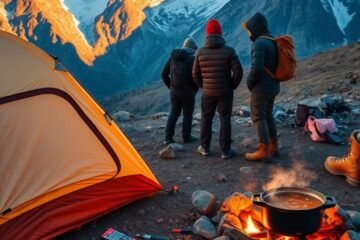

0 Comments